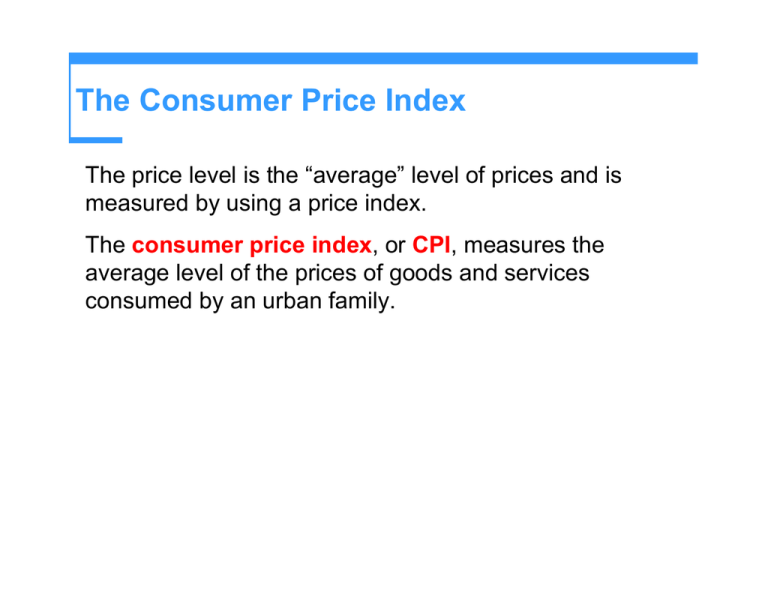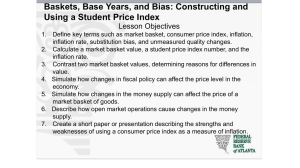The Consumer Price Index
advertisement

The Consumer Price Index The price level is the “average” level of prices and is measured by using a price index. The consumer price index, or CPI, measures the average level of the prices of goods and services consumed by an urban family. The Consumer Price Index Reading the CPI Numbers The CPI is defined to equal 100 for the reference base period. The value of the CPI for any other period is calculated by taking the ratio of the current cost of a market basket of goods to the cost of the same market basket of goods in the reference base period and multiplying by 100. The Consumer Price Index Constructing the CPI Constructing the CPI involves three stages: Selecting the CPI basket Conducting a monthly price survey Using the prices and the basket to calculate the CPI The Consumer Price Index Figure 6.12 illustrates the CPI basket. Housing is the largest component. Transportation and food and beverages are the next largest components. The remaining components account for only 26 percent of the basket. The Consumer Price Index The CPI basket is based on a Consumer Expenditure Survey. The current CPI is based on a 1993-95 survey, although the reference base period is still 1982-84. Every month, BLS employees check the prices of 80,000 goods and services in 30 metropolitan areas. The CPI is calculated using the prices and the contents of the basket. The Consumer Price Index For a simple economy that consumes only oranges and haircuts, we can calculate the CPI. The CPI basket is 10 oranges and 5 haircuts. Item Quantity Price Cost of CPI basket Oranges 10 $1.00 $10 Haircuts 5 $8.00 $40 Cost of CPI basket at base period prices $50 The Consumer Price Index This table shows the prices in the base period. The cost of the CPI basket in the base period was $50. Item Quantity Price Cost of CPI basket Oranges 10 $1.00 $10 Haircuts 5 $8.00 $40 Cost of CPI basket at base period prices $50 The Consumer Price Index This table shows the prices in the current period. The cost of the CPI basket in the current period is $70. Item Quantity Price Cost of CPI basket Oranges 10 $2.00 $20 Haircuts 5 $10.00 $50 Cost of CPI basket at base period prices $70 The Consumer Price Index The CPI is calculated using the formula: CPI = (Cost of basket in current period/Cost of basket in base period) × 100. Using the numbers for the simple example, the CPI is CPI = ($70/$50) × 100 = 140. The CPI is 40 percent higher in the current period than in the base period. The Consumer Price Index Measuring Inflation The main purpose of the CPI is to measure inflation. The inflation rate is the percentage change in the price level from one year to the next. The inflation formula is: Inflation rate = [(CPI this year – CPI last year)/CPI last year] × 100. The Consumer Price Index Figure 6.13 shows the CPI and the inflation rate, 1973– 2003. The Consumer Price Index The Biased CPI The CPI may overstate the true inflation for four reasons New goods bias Quality change bias Commodity substitution bias Outlet substitution bias. The Consumer Price Index The Biased CPI New goods bias New goods that were not available in the base year appear and, if they are more expensive than the goods they replace, the price level may be biased higher. Similarly, if they are cheaper than the goods they replace, but not yet in the CPI basket, they bias the CPI upward. Quality change bias Quality improvements generally are neglected, so quality improvements that lead to price hikes are considered purely inflationary. The Consumer Price Index The Biased CPI Commodity substitution bias The market basket of goods used in calculating the CPI is fixed and does not take into account consumers’ substitutions away from goods whose relative prices increase. Outlet substitution bias As the structure of retailing changes, people switch to buying from cheaper sources, but the CPI, as measured, does not take account of this outlet substitution. The Consumer Price Index The Biased CPI A Congressional Advisory Commission estimated that the CPI overstates inflation by 1.1 percentage points a year. The bias in the CPI distorts private contracts, increases government outlays (close to a third of government outlays are linked to the CPI), and biases estimates of real earnings. To reduce the bias in the CPI, the BLS will undertake consumer expenditure surveys more frequently and revise the CPI basket every two years. THE END





